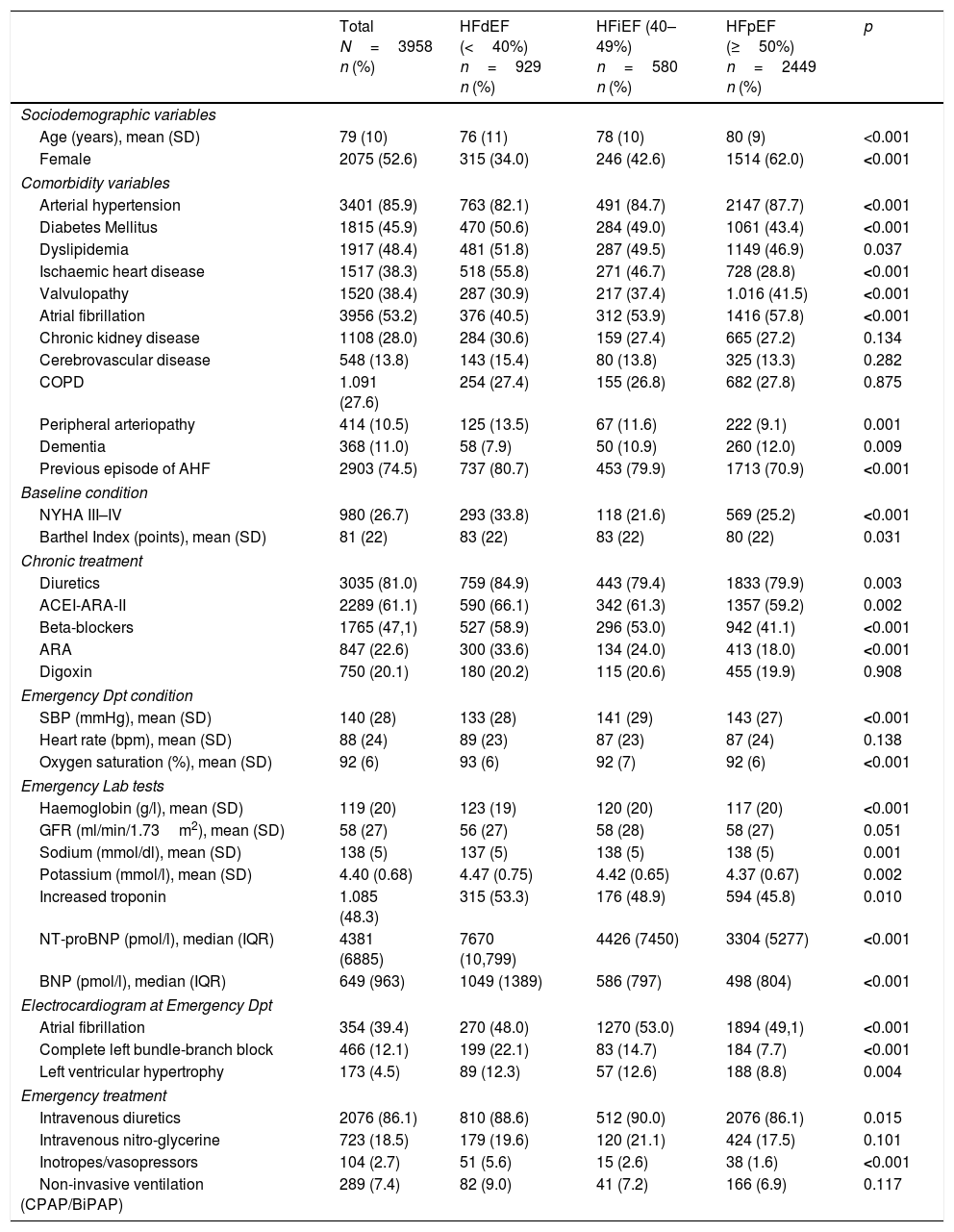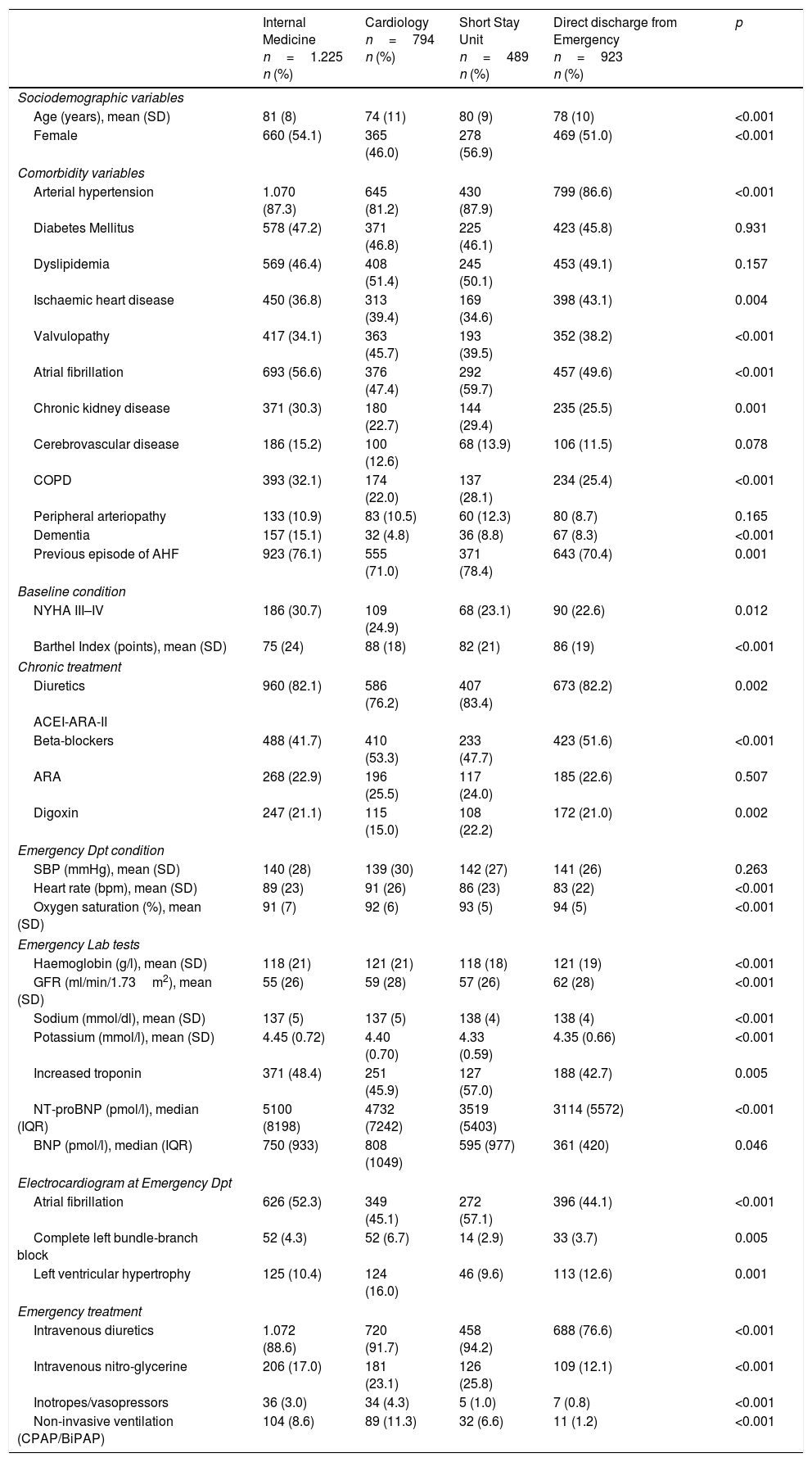To compare the outcome of patients with acute heart failure (AHF) with a mid-range left ventricular ejection fraction (HFmrEF) with patients with a reduced (HFrEF) or preserved (HFpEF) left ventricular ejection fraction.
Patients and methodA prospective observational study included patients diagnosed with AHF in 41 emergency departments. Patients were divided into 3 groups: HFrEF <40%, HFmrEF 40–49% and HFpEF ≥50%. We collected 38 independent variables and the adjusted and crude all-cause mortality at one-year in the HFmrEF group was compared with that of the HFrEF and HFpEF groups. The analysis was stratified according to patient destination following ED care.
ResultsThree thousand nine hundred and fifty-eight patients were included: 580 HFmrEF (14.6%), 929 HFrEF (23.5%) and 2449 HFpEF (61.9%). Global mortality at one year was 28.5%. The crude mortality of the HFmrEF group was similar to that of the HFpEF group (HR 1.009; 95% CI 0.819–1.243; p=0.933) and lower than the HFrEF group (HR 0.800; 95% CI 0.635–1.008; p=0.058), but after adjustment for discordant basal characteristics among groups, the mortality of the HFmrEF group did not differ from that of the HFpEF (HRa 1.025; 95% CI 0.825–1.275; p=0.821) or HFrEF group (HRa 0.924; 95% CI 0.720–1.186; p=0.535). Neither were significant differences found between the HFmrEF group and the other 2 groups in the analysis stratified according to admission or discharge direct from the emergency department.
ConclusionMortality at one-year after an AHF episode in patients with HFmrEF does not differ from that of patients with HFpEF or HfrEF, either globally or based on the main destinations after emergency department care.
Comparar la evolución tras una descompensación aguda de los pacientes con insuficiencia cardiaca (ICA) con fracción de eyección del ventrículo izquierdo intermedia (ICFEi) respecto a los que la tienen deprimida (ICFEd) o conservada (ICFEc).
Pacientes y métodoEstudio observacional prospectivo, de inclusión consecutiva de pacientes diagnosticados de ICA en 41 servicios de urgencias. Se formaron 3 grupos: ICFEd<40%, ICFEi 40-49% e ICFEc≥50%. Se recogieron 38 variables independientes y se comparó la mortalidad por cualquier causa al año en el grupo de ICFEi, bruta y ajustada, respecto a los de ICFEd e ICFEc. Se estratificó este análisis según el destino del paciente tras la asistencia urgente.
ResultadosSe incluyeron 3.958 pacientes: 580 ICFEi (14.6%), 929 ICFEd (23.5%) y 2.449 ICFEc (61.9%). La mortalidad global al año fue del 28.5%. La mortalidad bruta en la ICFEi fue similar a la ICFEc (HR 1,009; IC 95% 0,819-1,243; p=0,933) y menor que la ICFEd (HR 0,800; IC 95% 0,635-1,008; p=0,058), pero tras el ajuste por las características basales discordantes entre grupos, la mortalidad de la ICFEi no difirió de la ICFEc (HRa 1,025; IC 95% 0,825-1,275; p=0,821) ni de la ICFEd (HRa 0,924; IC 95% 0,720-1,186; p=0,535). El análisis estratificado según el destino del ingreso o alta directa desde Urgencias tampoco mostró diferencias significativas entre la ICFEi y los otros 2 grupos.
ConclusiónLa mortalidad a un año tras un episodio de ICA en pacientes con ICFEi no difiere de la de los pacientes con ICFEc o ICFEd, ni globalmente ni para ninguno de los principales destinos tras la asistencia en Urgencias.
Artículo
Comprando el artículo el PDF del mismo podrá ser descargado
Precio 19,34 €
Comprar ahora












